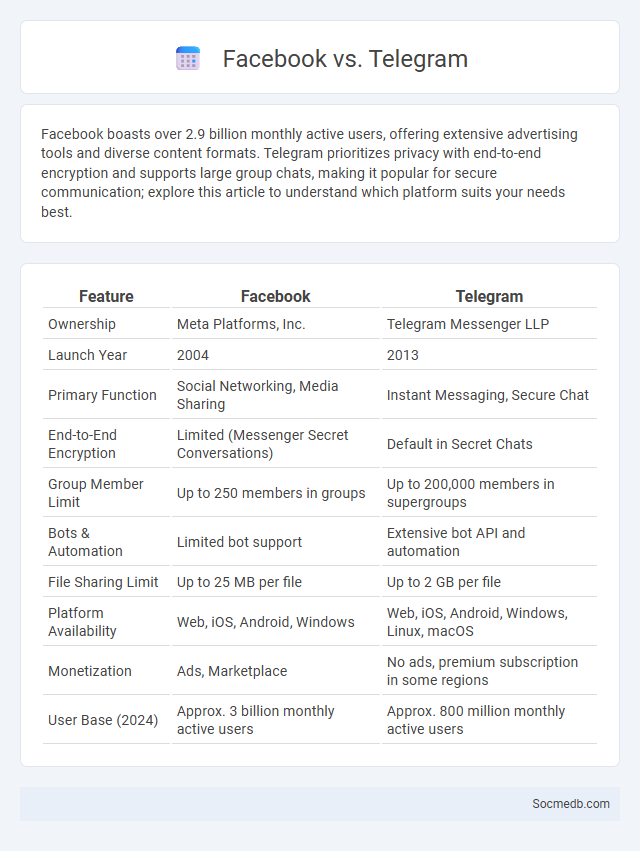
Photo illustration: Facebook vs Telegram
Facebook boasts over 2.9 billion monthly active users, offering extensive advertising tools and diverse content formats. Telegram prioritizes privacy with end-to-end encryption and supports large group chats, making it popular for secure communication; explore this article to understand which platform suits your needs best.
Table of Comparison
| Feature | Telegram | |
|---|---|---|
| Ownership | Meta Platforms, Inc. | Telegram Messenger LLP |
| Launch Year | 2004 | 2013 |
| Primary Function | Social Networking, Media Sharing | Instant Messaging, Secure Chat |
| End-to-End Encryption | Limited (Messenger Secret Conversations) | Default in Secret Chats |
| Group Member Limit | Up to 250 members in groups | Up to 200,000 members in supergroups |
| Bots & Automation | Limited bot support | Extensive bot API and automation |
| File Sharing Limit | Up to 25 MB per file | Up to 2 GB per file |
| Platform Availability | Web, iOS, Android, Windows | Web, iOS, Android, Windows, Linux, macOS |
| Monetization | Ads, Marketplace | No ads, premium subscription in some regions |
| User Base (2024) | Approx. 3 billion monthly active users | Approx. 800 million monthly active users |
Introduction to Social Media Messaging Platforms
Social media messaging platforms like WhatsApp, Facebook Messenger, and Telegram offer instant communication through text, voice, and video, connecting billions of users worldwide. These platforms support features such as group chats, multimedia sharing, and end-to-end encryption, ensuring secure and versatile conversations. Understanding how your messaging apps integrate with social media networks enhances online interaction and personal connectivity.
Overview of Facebook Messenger
Facebook Messenger is a widely used instant messaging platform with over 1.3 billion active users worldwide, enabling text, voice, and video communication. It integrates seamlessly with Facebook's social network, offering features like group chats, multimedia sharing, end-to-end encryption, and business communication tools. The app supports cross-platform messaging, allowing users to connect across devices including smartphones, tablets, and desktops.
Features and Functionality of Telegram
Telegram offers robust features including encrypted messaging, file sharing up to 2GB, and customizable chat themes for enhanced user experience. Its powerful bots and channels facilitate automated services and mass communication, making it ideal for communities and businesses. You can leverage Telegram's cross-platform synchronization to stay connected seamlessly on multiple devices.
What Are Third-Party Messaging Apps?
Third-party messaging apps are communication platforms developed by external companies, independent of the original social media or smartphone operating system providers. These apps enable You to send texts, images, videos, and voice messages securely and often offer enhanced features like end-to-end encryption, group chats, and customizable themes. Popular third-party messaging apps include WhatsApp, Telegram, and Signal, which prioritize user privacy and seamless cross-platform functionality.
Security and Privacy Comparison
Social media platforms vary significantly in their security measures and privacy policies, affecting how your personal data is protected and shared. Facebook and Instagram offer robust encryption but face frequent scrutiny over data transparency, while platforms like Signal emphasize end-to-end encryption and minimal data retention. Understanding these differences helps you make informed choices to safeguard your online presence effectively.
User Experience and Interface Differences
Social media platforms prioritize user experience by designing intuitive interfaces that enhance navigation and engagement tailored to diverse audience behaviors. Differences in layout, interaction patterns, and content presentation significantly impact how your interactions are perceived and the overall satisfaction with the platform. Optimizing interface elements like load times, accessibility features, and personalized content delivery ensures a seamless connection between you and the social media environment.
Cross-Platform Compatibility
Cross-platform compatibility in social media ensures seamless user experience across devices such as smartphones, tablets, and desktops by supporting various operating systems including iOS, Android, and Windows. This compatibility enhances engagement by allowing users to access content and interact with platforms like Facebook, Instagram, and Twitter without functionality loss. Optimizing applications for cross-platform use involves responsive design, consistent UI/UX, and integration with APIs to maintain performance and synchronization of data.
Group Chat and Community Management
Group chat platforms enable real-time communication, fostering close-knit interactions and seamless collaboration among members. Effective community management cultivates engagement, maintains positive discourse, and ensures your social media groups remain active and valuable. Leveraging tools like moderation controls and analytics can optimize user experience and growth within digital communities.
Customization and Integration Features
Social media platforms offer extensive customization features allowing users to personalize their profiles, content preferences, and notification settings, enhancing user engagement and satisfaction. Integration capabilities connect social media with third-party applications and services such as e-commerce tools, analytics software, and marketing platforms, streamlining workflows and expanding functionality. These combined customization and integration features drive more tailored user experiences and efficient digital marketing strategies.
Choosing the Right Messaging App for Your Needs
Selecting the right messaging app depends on factors such as security features, user base, and platform compatibility. Apps like WhatsApp offer end-to-end encryption and a wide user network, while Signal prioritizes privacy with minimal data collection. Consider the balance between functionality and privacy to ensure the app aligns with personal or professional communication needs.
 socmedb.com
socmedb.com